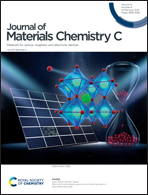Cesium-lead-bromide perovskites with balanced stoichiometry enabled by sodium-bromide doping for all-vacuum deposited silicon-based light-emitting diodes†
Abstract
Perovskite light-emitting diodes (PeLEDs) have drawn tremendous research attention recently. However, they are mainly prepared via solution processes, while the devices fabricated using the all-vacuum deposition procedure still remain largely unexplored. In this work, we prepared a cesium-lead-bromide perovskite film using the vacuum deposition method, and realized a more balanced stoichiometry by replacing some CsBr with NaBr. It was discovered that the introduction of an appropriate amount of NaBr not only reduced the insulating Cs4PbBr6 phase in the active layer, but also passivated the trap states effectively, which resulted in a 2-fold increase of the peak external quantum efficiency (EQE) of the PeLEDs to 2% with the maximum luminance reaching close to 40 000 cd m−2 and significantly improved device operational stability compared to the undoped counterparts. Furthermore, we fabricated the first top-emissive silicon-based PeLED using the all-vacuum deposition method based on the NaBr doped perovskite films, and achieved a peak EQE of 0.33%, which has provided a promising alternative way for the design and preparation of high-performance silicon-based display devices in the future.



 Please wait while we load your content...
Please wait while we load your content...